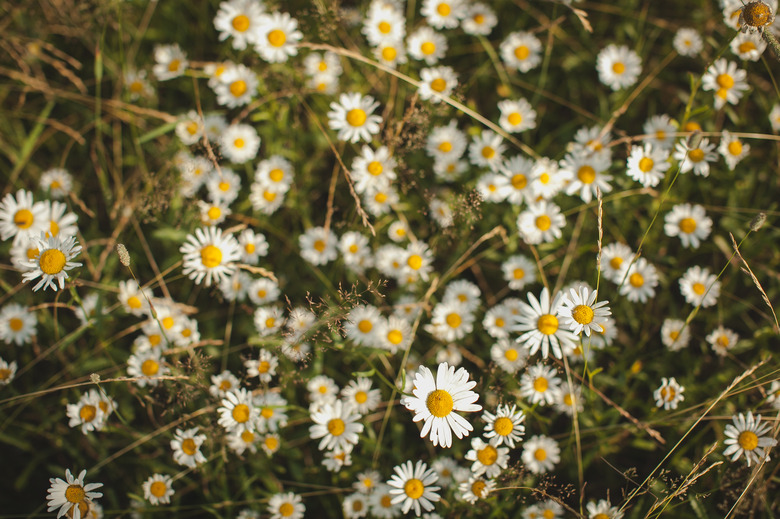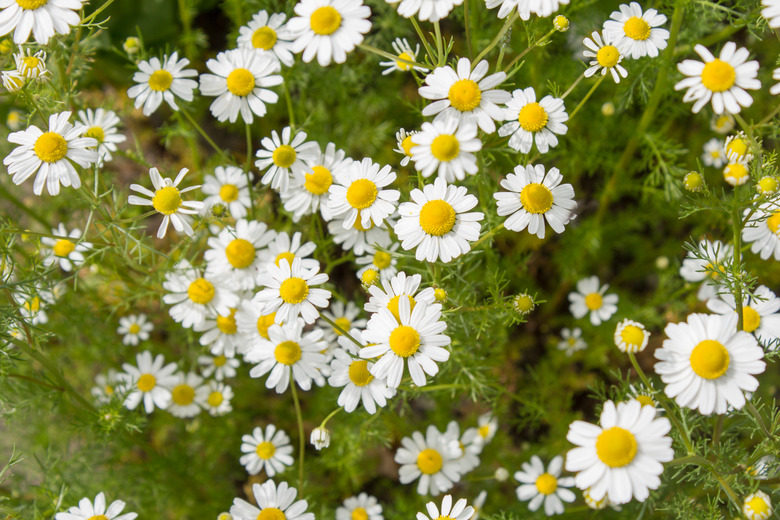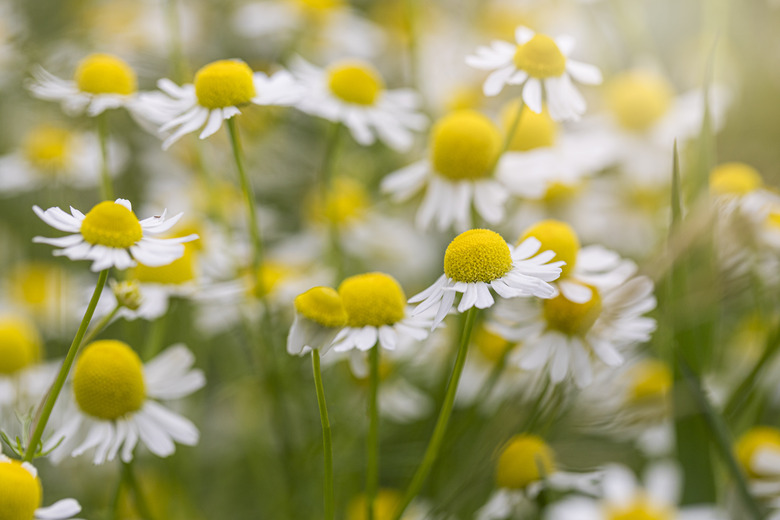How To Grow Chamomile
That chamomile tea you drink every morning has a long and storied history as a highly prized flower beloved by Egyptians, Romans and Greeks alike for its healing properties. True chamomile (Chamaemelum nobile, USDA zones 4-9) also known as Roman chamomile, is the most common form of this plant, with flower heads showcasing white petals and yellow centers. Displaying daisylike blooms, it's no wonder that it's a member of the sunflower family (Asteraceae) that also includes daisies. There are other chamomile species, such as German chamomile (Matricaria chamomilla), which is an annual plant.
Chamomile is rooted in folklore. Long touted for its medicinal properties, it's been used as an aromatherapeutic aid and a cure-all for centuries. For example, ancient Egyptians believed chamomile was a gift from the sun god Ra since it seemed to help with so many ailments. Egyptians also frequently used chamomile in their cosmetics and hair care treatments. In medieval times, people would spread chamomile flowers on the floor for a pleasant scent. It was also thought to banish negative energy from spaces. It's been used in European medicine since the first century A.D.
True chamomile plants are self-seeding, fast growing and can grow to around 2 feet tall. They're known for being hardy against light frosts and are drought tolerant and low maintenance.
Best Uses for Chamomile
Many gardeners grow chamomile as a medicinal herb that can be turned into a relaxing herbal tea. In fact, many scientific studies have proven that chamomile tea eases people to restful sleep, quiets anxiety, boosts immunity and pacifies troubled tummies. It's even been studied for its potential anti-cancer properties and its ability to prevent coronary heart disease.
The tea can be made by combining hot water with fresh flowers, or you can opt for making it with dried flowers, something that you can accomplish with a dehydrator. It can be used in salves or essential oils to smooth rough skin, soothe a sunburn, heal wounds, calm rashes or treat scars. It's also a tried-and-true aromatherapeutic scent that can calm nerves.
When choosing a spot to grow chamomile in your yard, plant it in full sun. If you live in a hot climate, aim to plant it in partial shade. Chamomile grows well in a raised bed and benefits from mulch spread around the plants, which aids in keeping the soil moist and prevents weed growth.
Chamomile is a fabulous companion plant in a vegetable garden, where it may help to repel cucumber beetles and utilizes its natural anti-bacterial and anti-fungal properties to combat fungus and mold.
Chamomile plants also make for terrific ground cover. People typically turn to Roman chamomile for lawns since it grows much shorter than German chamomile. When planted in an open area, chamomile flowers can creep and can even serve as a lawn that you'll never have to mow. Plus, it will attract pollinators and act as an attractive floral alternative to a traditional grass lawn.
Another way to grow chamomile is in containers, which is beneficial since it's a fast-growing plant that can quickly self-seed and take over gardens and other areas of your yard. It will do well on a balcony or on a front porch with full sun.
How to Grow Chamomile
- Common Name: Chamomile
- Botanical Name:
Chamaemelum nobile
- When to Plant: It can be planted after all danger of
frost has passed to make sure it becomes established before the next season's frosts and freezes. - USDA Zones: 4-9
- Sun Exposure: Full sun
- Soil Type: Well-drained, sandy soil
- When it's in Trouble: Yellowing leaves and dry leaf tips can
signal root rot, a side effect of overwatering - When it's Thriving: Produces healthy, blooming flowers and
multiplies quickly
Starting Chamomile From Seed
With chamomile, you have the option to sow seeds indoors and then plant the chamomile seedlings outside after the last danger of frost has passed. You can sow the chamomile seeds indoors six to eight weeks before the final frost. Sow them in at least 1/4 inch of soil depth and place them under a grow light or on a sunny windowsill where the temperature of the soil can remain around 70 degrees Fahrenheit. You'll start seeing chamomile seedlings in two to three weeks.
You can sow the German chamomile seeds directly in the garden. Again, wait until after the last frost to sow your seeds in well-drained soil that's in full sun. Sow the seeds 1/4 inch deep, keep 12 inches of space between rows and allow 2 inches between seeds. The seedlings will emerge in two to three weeks.
In What Zone Does Chamomile Grow Best?
Chamomile grows best in USDA hardiness zones 4-9, where it can enjoy relatively cool temperatures as opposed to oppressive heat. Although it can tolerate frost when planted in its hardiness range, if you live on the edge of zone 4 and expect a springtime heavy frost, cover young chamomile seedlings with straw or use a row cover to protect them.
If you live on the edge of zone 9 and your climate is prone to extreme heat, be sure to plant chamomile in partial shade or plant it in containers so you can have the option to move it to a shady spot or even bring it indoors.
Soil, Sunlight and Water Recommendations for Chamomile
Chamomile thrives in sandy, well-drained soil that isn't overly moist. Plant it in a spot in your garden where the water can drain quickly after a rainfall. It prefers full sun, but in hot climates, partial shade is an option to offer it some protection against too much sun and heat. Once a month, you can also use a phosphorous-rich, water-soluble fertilizer.
During the growing season, keep chamomile plants well watered. They'll need around an inch of water per week, and it can be helpful to have a rain gauge nearby to know if you need to give them any extra water during a dry spell.
When choosing a spot to grow chamomile in your yard, look for a spot that gets full sun. If you live in a hot climate, aim to plant it in partial shade. Chamomile grows well in a raised bed and benefits from mulch spread around the plants, which aids in keeping the soil moist and prevents weed growth.
How to Harvest Chamomile
Unlike other herbs that are often harvested for their leaves, you'll be focusing on the flowers when harvesting chamomile. The time to harvest is when the blossoms are in full bloom but before the petals begin to wilt. You should harvest them regularly as this will encourage continuous growth of new blossoms so you can harvest the plants several times over.
Try to harvest chamomile on a dry day and first thing in the morning before any dew settles upon the plants. Simply pinch each flower just below the flower head, popping them off as you go. Leave behind any flowers that are still budding.
Common Pests and Other Problems for Chamomile
Even though they are hardy, chamomile plants are prone to some issues. Root rot and droopy leaves can be brought on by overwatering, which means you're watering more than the prescribed 1 inch of water per week. If the soil is dry and growth has slowed, you're likely underwatering your chamomile plants.
There are some pests that can plague chamomile plants, but on the flip side, there are beneficial insects that can actually help the plants. With their sweet scent and bright colors, chamomile plants easily attract pollinators, such as ladybugs, honeybees and beneficial wasps.
Some of the pests that chamomile doesn't particularly enjoy include:
- Aphids: These teeny-tiny insects can spread all
over the underside of chamomile leaves, leaving behind a residue that attracts
ants. You can blast them off using water from a hose or simply use a cloth to
wipe them away. - Spider mites: Small and spiderlike, these bugs
can literally remove chlorophyll from chamomile and replace it with harmful
toxins, which cause white dots to form on the plants. There are some essential
oil scents that will deter them, like rosemary, thyme and peppermint. You can add 10 drops of each oil to a 4-ounce glass spray bottle. Dilute it by filling the rest of the bottle with water. Shake to combine and spray it anywhere you would like to deter insects. - Mealybugs: These wingless insects look like
diminutive pieces of cotton on chamomile leaves and stems. They'll suck the
juices from the leaves, which will weaken the plants. A stream of water to dislodge them will
let them know they've worn out their welcome. - Scale insects: Similar to mealybugs, these
oval-shaped insects also suck the juices from the leaves. You can pick them from
the plants by scraping them off with a fingernail. - Thrips: These minuscule green bugs do a good job
of thoroughly scraping at leaves, which in turn can make leaves appear splotchy
and twisted. Emerging from the soil, you can control thrips by removing weeds
from your garden or putting down dry mulch. Since the adult insects emerge from the soil, you can control them by removing alternative food sources like weeds and dead leaves from your garden to prevent outbreaks. In addition to weeding, mulch can keep weeds at bay.
Common Diseases for Chamomile
There are some commonly seen diseases that can impact your chamomile plants. Even though chamomile has anti-fungal properties, it's not ironclad and can be prone to fungal issues.
- Powdery mildew: Those white, powdery patches on
your chamomile plants are a sign of powdery mildew, a fungus carried on the
wind that can be seen on the leaves and stems. This can bring on yellow leaves
or leaves that die completely. Planting your chamomile in a sunny spot,
providing good air circulation and avoiding excess fertilizer should
help. - White rust: Also known as blister rust, this
disease causes white blisters to form on the underside of leaves. Wet leaves
can encourage the growth of these blisters. To avoid this problem, try to keep
the leaves dry if possible. Drip irrigation can be beneficial. - Botrytis blight: A fungal issue, this disease will
make yellow patches appear on the leaves and stems of your chamomile plants. If
the leaves stay wet for a while, the rotting brings about blight. You'll need
to take action as soon as you see that this is happening. You can either remove
the diseased plants or apply a fungicide. - Root and crown rot: Starting as yellowed leaves
and progressing to branches that turn brown and die off, these ailments come
about as a result of overwatering. These diseases thrive in standing water and soggy soils, so
be sure to keep your soil well drained and only water your plants the recommended 1
inch every week. - Damping off: This problem can arise if you've
started your chamomile plants from seed. Damping off is a fungal issue that causes
chamomile to wilt and die quickly. Overabundant moisture is often the cause. You
should avoid overwatering your seedlings, offer good air circulation in your
garden and thin out seedlings as needed to head off overcrowding.


